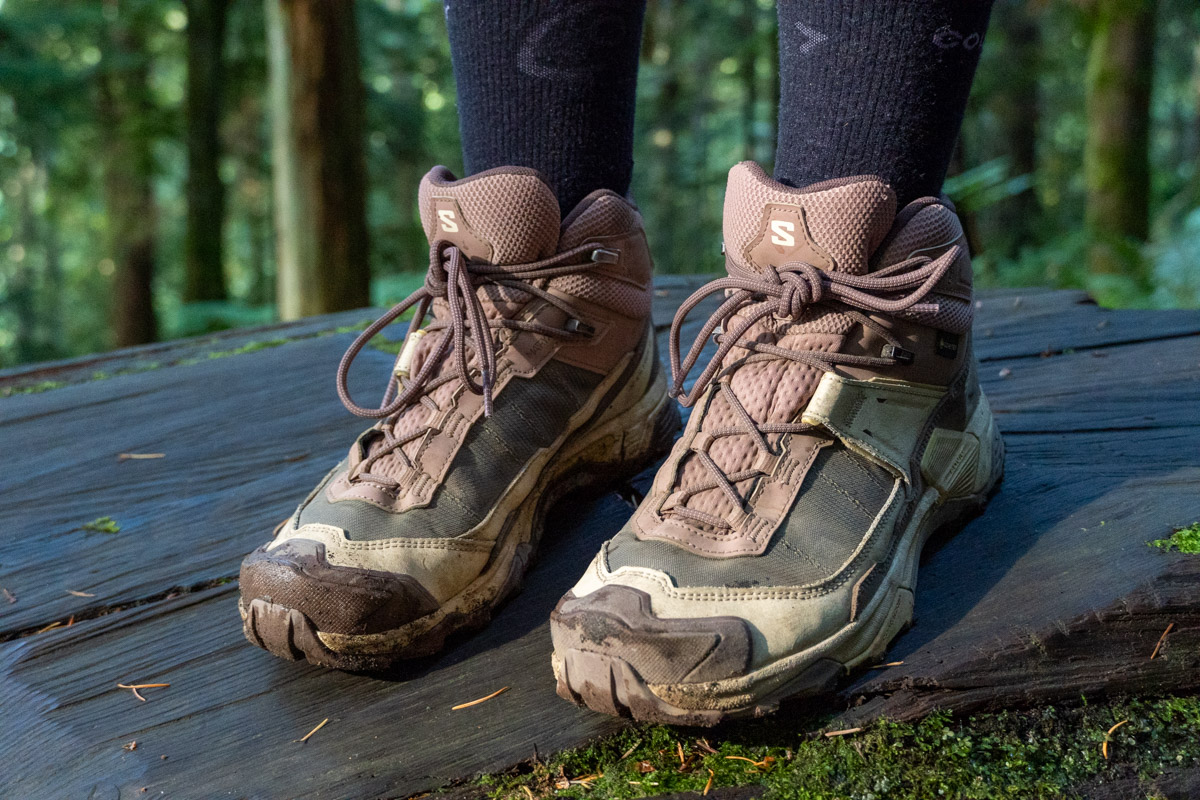
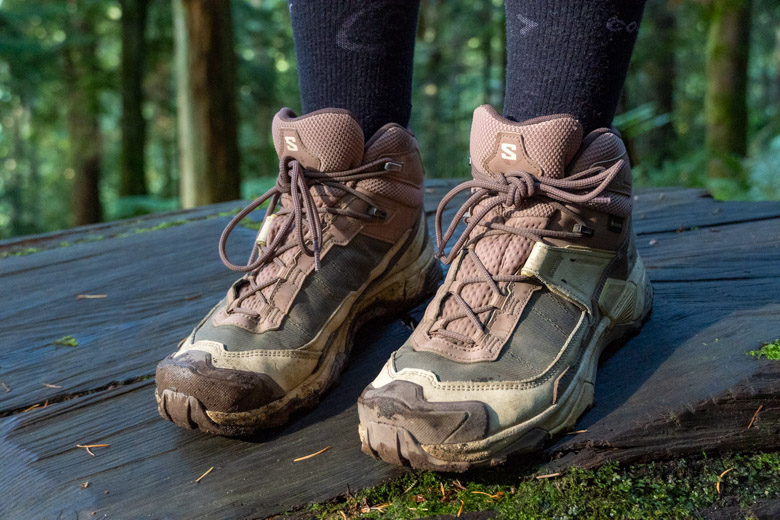
Adam Zukowski


Adam Zukowski
Price: $185
Weight: 1 lb. 13.4 oz. (women’s size 8.5)
Waterproof: Yes (Gore-Tex)
What we like: A lightweight yet durable and stable hiking boot that easily tackles a range of terrain.
What we don’t: The fit runs large, and it's not very plush underfoot.
See the Women's Salomon X Ultra 5 Mid Gore-Tex See the Men's Salomon X Ultra 5 Mid Gore-Tex
Salomon’s X Ultra line has been a long-time favorite among hikers, backpackers, and backcountry explorers alike. The latest version to their high-top hiking boot, the X Ultra 5 Mid GTX, features some notable upgrades from the outgoing 4, including a more durable upper and outsole construction. After testing this boot on several day hikes in western Washington and a 50-mile backpacking trip in Washington’s Pasayten Wilderness, I’ve come away impressed with its ability to tackle a range of terrain. That said, I do have some gripes with the comfort and sizing of the boot (simply put, it might be worth upgrading to a cushier insole if you plan on hiking far with a heavy pack). Below I detail my experiences with the Salomon X Ultra 5 Mid GTX hiking boot, but for a more comprehensive view of the market, check out our articles on the best hiking boots, best women's hiking boots, and best waterproof hiking boots.
When putting on the Salomon X Ultra 5 Mid GTX for the first time out of the box, I was optimistic about its comfort. The padding along the collar and tongue is soft, and the upper materials are supple and lightweight. The included Ortholite insoles provide a decent amount of cushion, though the midsole is far from a super plush option from a brand like Hoka. But as someone who prefers a grounded shoe, I was excited to get it out on the trail. I broke the X Ultra 5 in on a few day hikes and found them to be as comfortable as I expected. While it quickly became clear that they were a bit too big for me (read more about fit and sizing below), I wasn’t too concerned that it would be a problem.

That said, my opinion changed when I took the X Ultra 5 Mid on a 50-mile backpacking trip in Washington’s Pasayten Wilderness. There were several factors that led to discomfort on this trek, which ultimately forced my partner and me to cut the trip short. I’ll admit that I was nursing some plantar fasciitis on my left heel going into the hike, but the lack of under-heel cushion exacerbated the issue and caused similar pain in my right heel. And while I assumed I’d appreciate the larger fit when my feet swelled, the swimming feeling caused some blisters on the bottoms of my feet. There is also a significant gap where the heel of the Ortholite insole meets the boot, which pinched my heels with every step I took. And likely due to overtightening the laces, I experienced some irritation along my pinky toes where they rubbed against the inside of the shoe. It’s worth noting that comfort is subjective, and the issues I had could be mitigated by replacing the insole with a more cushioned design and sizing down by half a size.

On my scale, the pair of women’s 8.5 X Ultra 5 Mids that I tested weighed 1 pound 13.4 ounces, which is a few ounces heavier than the last version (1 lb. 10.1 oz.). That said, the weight is still competitively low for the market. Salomon’s beefier leather Quest 4 GTX, for instance, weighs significantly more at 2 pounds 5.7 ounces for the pair. There are certainly lighter weight synthetic options, like Keen’s Zionic Waterproof Mid (1 lb. 8.6 oz.) and NNormal’s Tomir Waterproof Boot (1 lb. 5.4 oz.), but both sacrifice cushion, stability, and protection in the effort to shave a few ounces. When wearing the X Ultra 5 Mid, I didn't think it felt heavy or clunky, and I liked the extra security in the beefy toe bumpers and tread.

The latest version of the X Ultra Mid features deeper and more durable lugs than the previous version. I’m a big fan of Salomon’s Contragrip outsole in their hiking and running shoes, so it’s little surprise that I found the X Ultra Mid 5 confidence-inspiring on a range of terrain. They gripped easily onto the rocky and loose trails in the Pasayten, and they had no issue tackling the muddy and soft trails I encountered while day hiking in western Washington. I trusted them to tackle tricky stream crossing as well. The tread only failed me once when I tried to scramble onto a wet granite boulder for a photo, but in all fairness, most boots would have had the same issue in this scenario.
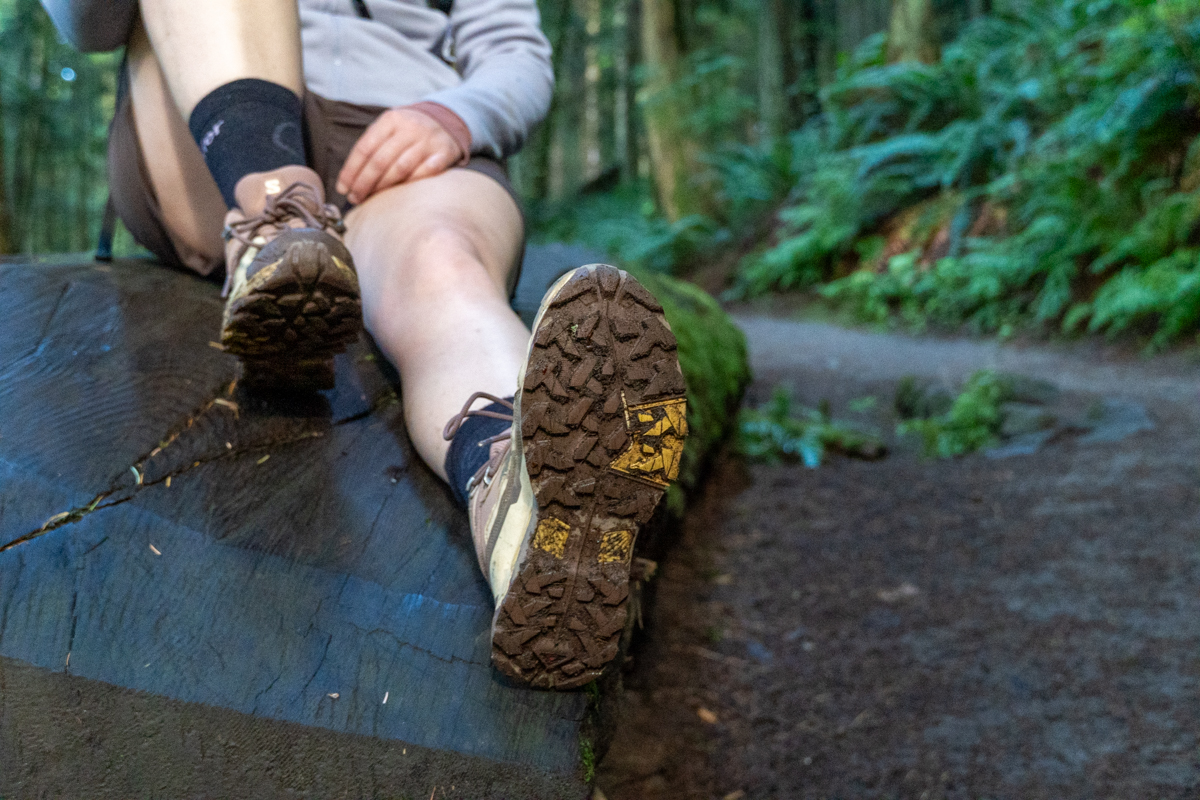
As mentioned above, I struggled with the underfoot support in the X Ultra Mid 5. While I normally prefer a grounded shoe, the lack of midsole cushion made hiking on the rocky Pasayten trails jarring and painful. However, I found the rest of the boot fairly supportive. Salomon’s Active Support wings secured my foot in the shoe, keeping them from shifting forward even on long stretches of downhill trail. The upper materials are flexible and comfortable when climbing steep hills. We had issues with the ankle support in the previous version, but I found the high collar of the 5 sufficient even when hauling a heavy backpacking pack on loose trails or when bushwhacking. That said, I’d recommend a hiking boot with a more supportive collar if you’re especially prone to ankle rolling, such as Salomon’s Quest 4. Lastly, I struggled to keep the laces knotted, which sometimes affected the support. Even when double-knotting, the laces managed to loosen themselves every 5 to 7 miles.
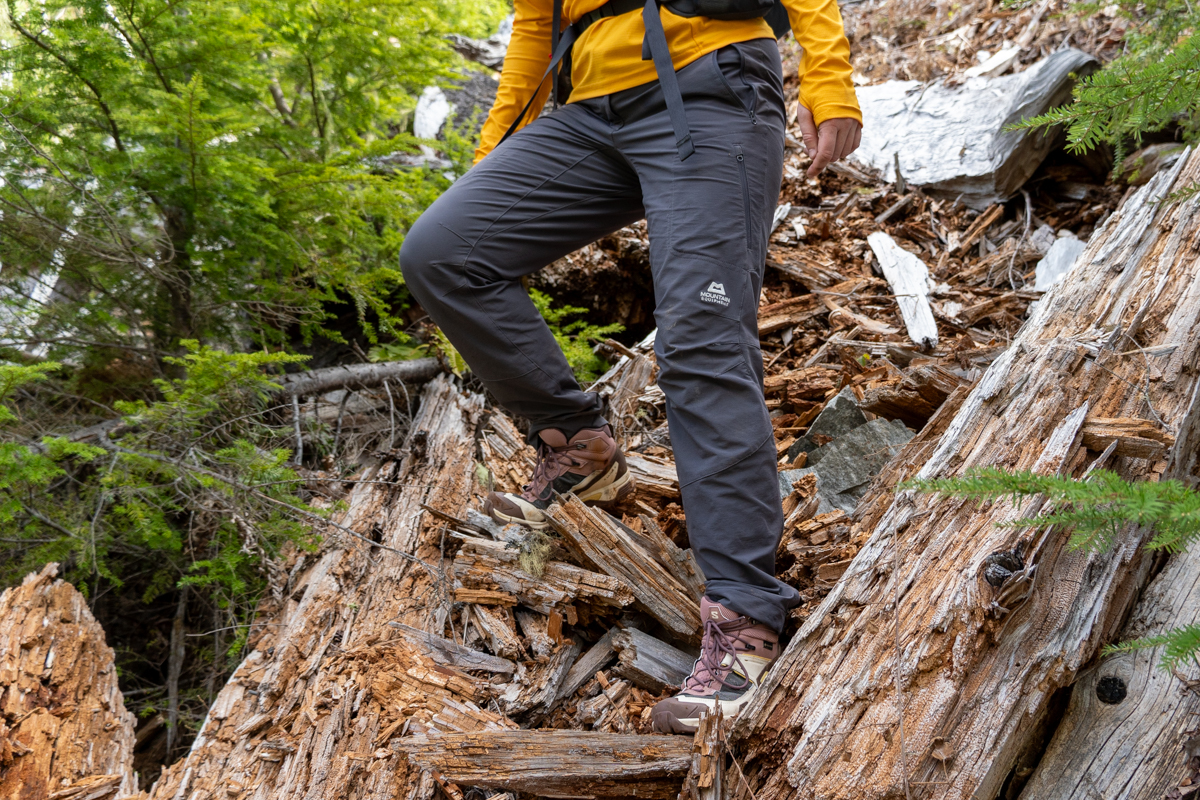
During the last push to the trailhead, I can’t say my footwork was graceful, but the X Ultra 5 Mid has a number of protective features that kept my feet safe. Most notably, it features a wrap-around rubber bumper that extends over the top of the toe. No matter how many rocks and roots I kicked, my toes remained pain-free (the too-large fit likely also helped). The heel cap is also beefy and impenetrable, providing a decent buffer from sharp trail features without eliminating a ground connection all together. The X Ultra 5 Mid offers a serious step up in protection over trail running shoes or minimalist/lightweight hiking boots and shoes without veering on overbuilt.
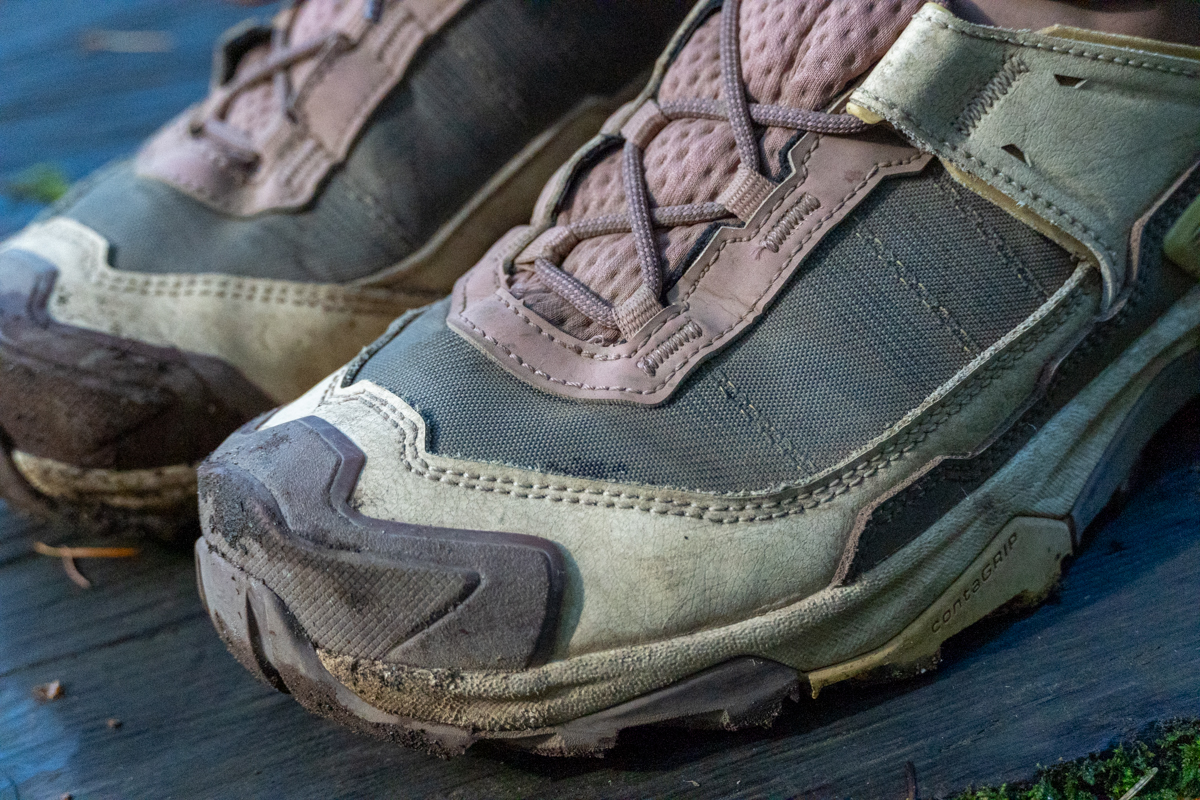
The X Ultra 5 Mid is outfitted with Gore-Tex’s proven waterproofing, and I experienced no issues crossing streams or muddy sections of trails. The upper material and gusseted tongue was protective in deep crossings too, even above the lacing system. This is one of the benefits of opting for a high-top waterproof boot over a hiking shoe: You don’t have to be so cautious about the waterline. Though the Mid version of the X Ultra 5 is a bit pricier than the low-top shoe, it’s a real benefit if you plan on tackling seriously muddy trails or deeper stream crossings.
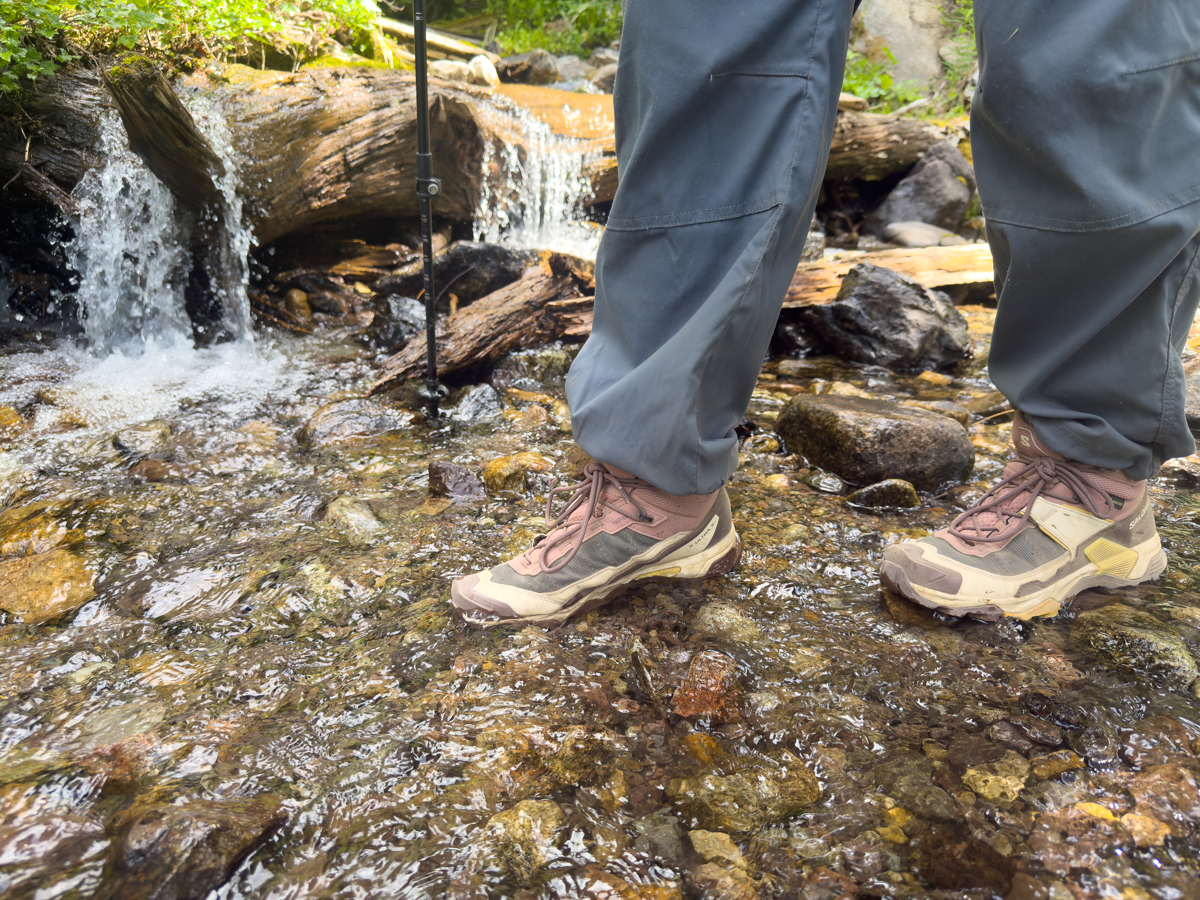
As is the case with most waterproof hiking boots and shoes, the X Ultra Mid 5 does suffer a bit in terms of breathability. However, I was pleasantly surprised by how well they handled the 80-degree Fahrenheit temps in the Pasayten Wilderness. Even when hiking through old burn scars with exposed sun, my feet remained relatively dry. Sure, my socks were a little damp by the time we reached camp, but I’ve experienced much worse with heavier leather hiking boots. Though, if you’re planning on hiking exclusively in hot and dry conditions, it’s worth opting for a non-waterproof boot. Unfortunately, at the time of publishing the X Ultra 5 Mid is only available with the Gore-Tex membrane, but Salomon does offer a non-waterproof X Ultra 5 shoe.

Many users reported durability concerns with the previous X Ultra 4, but the updated X Ultra 5 Mid has so far proven well-built and hard-wearing. The biggest upgrade is the upper material, which Salomon calls Matryx: It’s a mixture of yarn and Kevlar materials that boast serious durability while remaining lightweight and supple. To be sure, a leather hiking boot will likely be the more durable choice in the long term, but I’m so far unconcerned with blowing out this boot anytime soon. The rest of the design follows suit: The tread is free from any significant damage, despite the rocky granite trails I’ve hiked, and the cushioning along the tongue and ankle is still as plush as it was out of the box. So far, I’m impressed with the changes Salomon has made with material quality in the X Ultra 5, but I’ll be sure to report back with any issues as I continue to test them.
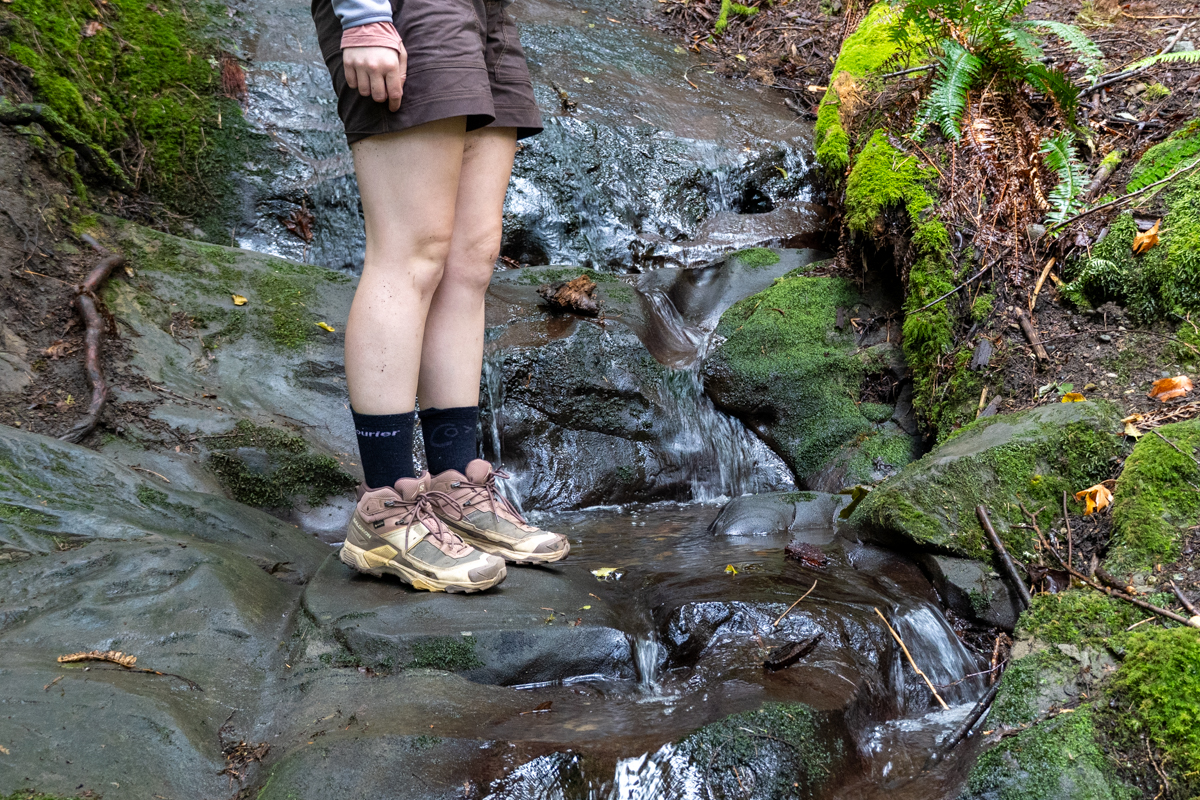
As mentioned previously, I found my regular women’s 8.5 too large in the X Ultra 5. To be more specific, the midfoot fit well, but the toe was far too long. I chalk up many (but not all) of the issues I had with comfort to the fit. For reference, I sized down to a women’s 8 in the non-waterproof X Ultra 5 shoe and have found it much more comfortable and easy to move in. That said, both have caused some irritation at the widest point of my foot, specifically in the pinky toe area. Salomon does offer a wide version of the X Ultra 5 Mid for men, but disappointingly not for women. In short, I highly recommend trying these boots on in person before buying to ensure you’re choosing the right size for your feet.
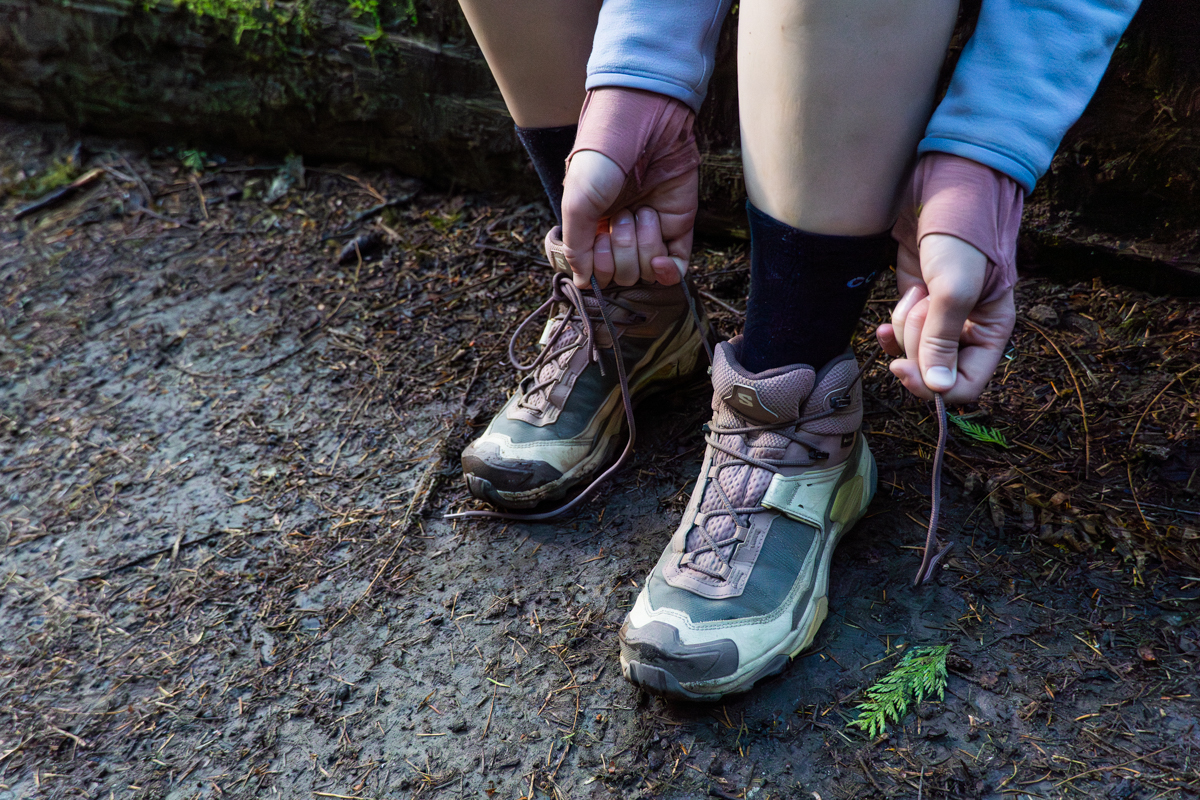
Like many outdoor brands of late, Salomon had their eye on sustainability with the latest update to the X Ultra line. The updated 5 Mid uses a PFAS-free Gore-Tex waterproofing that’s free from added harmful perfluorocarbons, which have proven resistant to breakdown in the environment. Salomon also utilized some recycled materials in this latest design, including those from material waste and PET bottles. I’d like to see more transparency on Salomon’s end regarding what percentage of the shoe is made of recycled materials, but I still think this is a good step in the right direction for the brand.
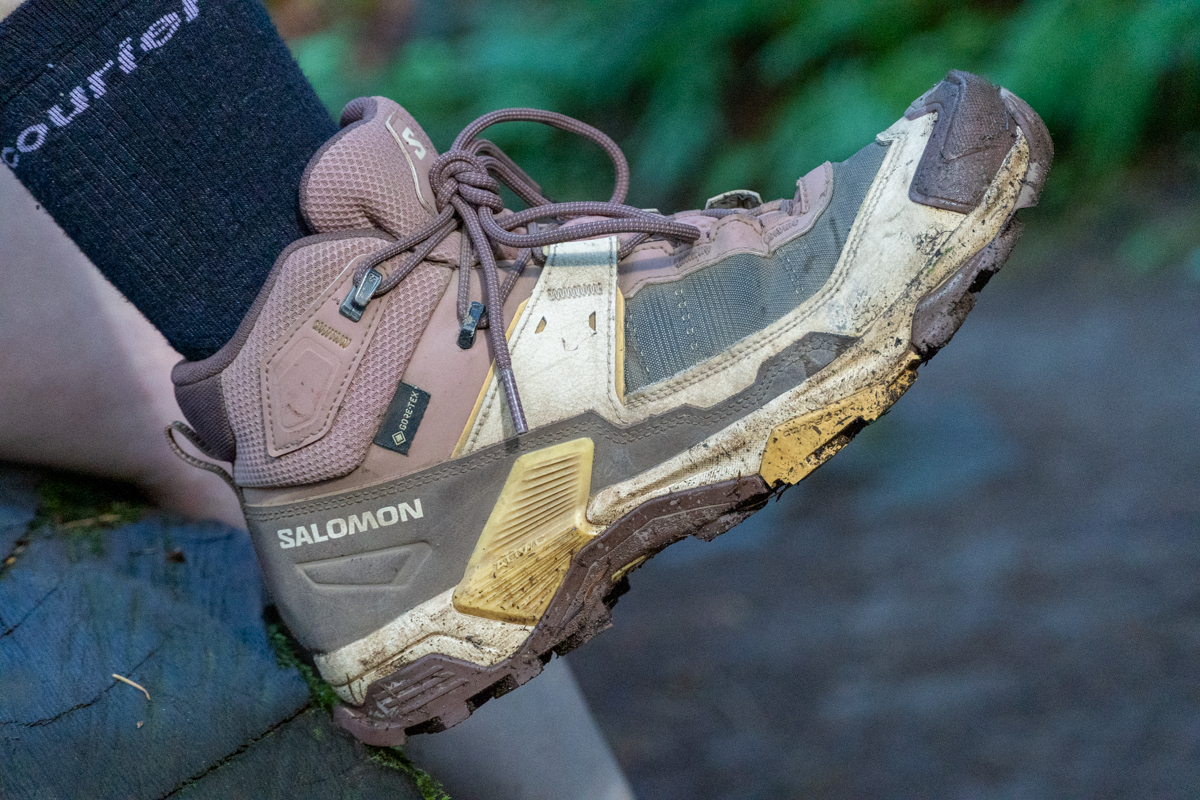
I tested the women’s version of the X Ultra 5 Mid GTX, and Salomon offers the boot in a men’s version as well for the same price. Other than color options and weight (1 lb. 15.0 oz.), the men’s version is identical to the women’s, and we expect it to perform similarly. If you prefer a low-top hiker, the X Ultra 5 is available in both a non-waterproof and waterproof shoe. Other than the collar height, weight, and price (the shoes are a bit cheaper and lighter weight than the boots), the main difference between the boots and the shoes is the lacing system: The shoes feature Salomon’s QuickLace system, which is a cinching cord. While the QuickLace system is much more efficient than the traditional lacing system on the Mid, we’ve found it makes dialing in a personalized fit much trickier. Lastly, it’s worth noting that the men’s versions in both the shoe and boot are offered in wide sizes, but the women's versions are not.

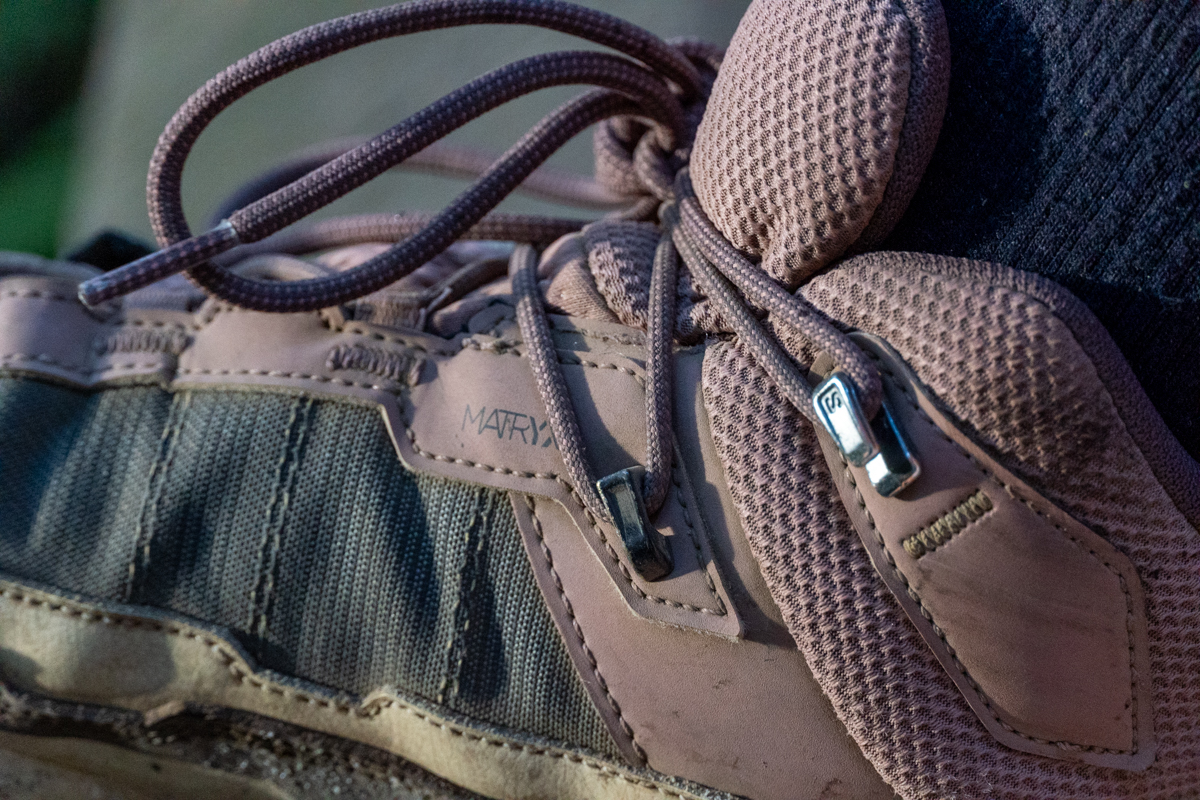
| Hiking Boot | Price | Category | Weight | Waterproof | Upper |
|---|---|---|---|---|---|
| Salomon X Ultra 5 Mid GTX | $185 | All-around | 1 lb. 13.4 oz. | Yes (Gore-Tex) | Synthetic |
| Salomon Quest 4 GTX | $230 | Mountain/all-around | 2 lb. 5.7 oz. | Yes (Gore-Tex) | Synthetic/leather |
| Merrell Moab 3 Mid Waterproof | $170 | All-around | 1 lb. 11.1 oz. | Yes (M-Select Dry) | Leather/mesh |
| Altra Lone Peak 9 WP Mid | $180 | Lightweight | 1 lb. 15.9 oz. | Yes (Cosmo lining) | Mesh |
| Hoka Anacapa 2 Mid GTX | $195 | All-around | 1 lb. 13.4 oz. | Yes (Gore-Tex) | Leather |
Salomon’s X Ultra line has achieved legendary status in the backpacking and hiking world, but there’s no shortage of options to consider. From within Salomon’s line, the Quest 4 GTX hiking boot strikes us as the most viable alternative. Compared to the X Ultra 5 Mid, the Quest 4 is beefier, more supportive, and comfortable. It does an equally great job at securing the foot inside the boot, but we prefer its stiffer collar when tackling challenging terrain with heavy loads. That said, the Quest 4 is overkill for most well-groomed trails and day hikes. It also costs and weighs much more than the X Ultra 5 Mid, which makes it a tough choice for weight-conscious backpackers.
There's a lot to like about Merrell's Moab 3 Mid Waterproof boot, too. Not only does it beat the X Ultra 5 a bit in terms of price, but we’ve found it far more comfortable than the X Ultra 5, especially underfoot and in the toe box. To be sure, it’s not as supportive as the X Ultra 5, Merrell’s in-house waterproofing isn’t as dependable as Gore-Tex, and the Vibram TC5 outsoles aren’t quite as confidence-inspiring as Salomon’s Contragrip, but the Moab 3 is still a great choice for a lightweight hiking boot. If you’re planning on sticking to mellow trails and don’t plan on carrying a heavy load very far, the Moab 3 is fully serviceable and comfortable.

Comfort is one of our biggest gripes with the X Ultra 5, specifically along the forefoot and underfoot. Those with finicky feet might have better luck with Altra’s and Hoka’s offerings. Altra’s Lone Peak 9 Waterproof Mid is a great choice for those with wider feet. This slipper-like shoe is comfortable out of the box and remains so as the miles add up. But stability and protection are the greatest compromises in going with the Altra: The soft upper and short toe bumper simply can’t match the X Ultra 5. If underfoot cushion is what you’re looking for, Hoka’s Anacapa 2 Mid GTX is a viable alternative. This boot features Hoka’s signature springy and rockered midsole and a fairly protective and supportive package. Though, for the price, we’ve been seriously disappointed by the durability of the Anacapa. In our opinion, the X Ultra 5 Mid is the more well-rounded choice, and a cushier insole can go a long way to mitigate many of the issues we faced.
Back to the Salomon X Ultra 5 Mid GTX Review See our Women's Hiking Boot Guide